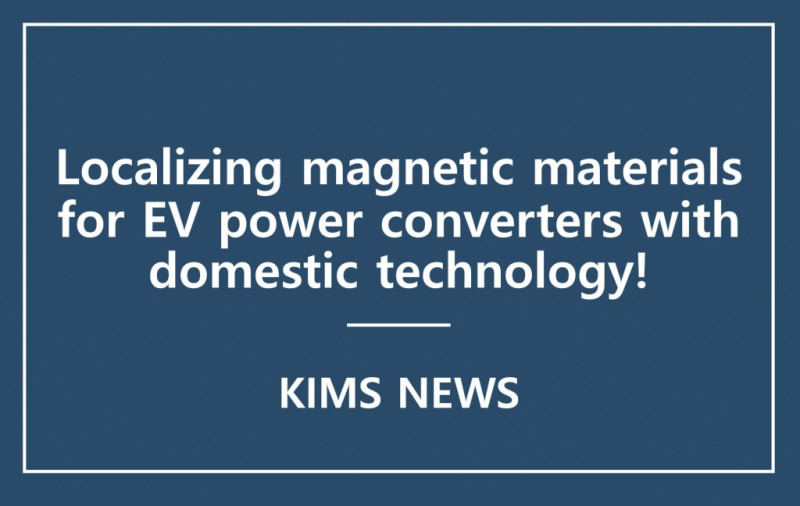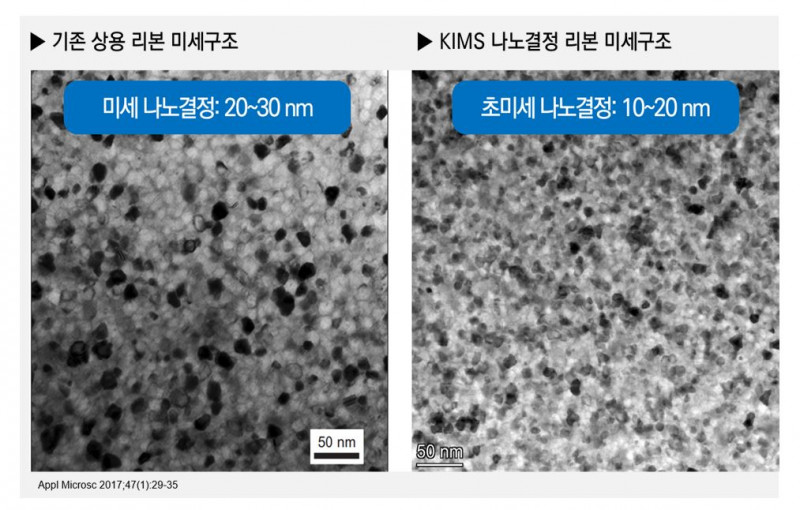R&D | KIMS developed nanocrystalline soft magnetic ribbon material with high saturation magnetization/high permeability
Page info
Date22-03-25 10:12 Hit595Link
Contents
Localizing magnetic materials for EV power converters with domestic technology! |
A research team led by Dr. Jeong Jae Won of the Department of Metal Powder at the Korea Institute of Materials Science (KIMS, President Jung-hwan Lee), a government-funded research institute under the Ministry of Science and ICT, succeeded in developing nanocrystalline soft magnetic ribbon material with high saturation magnetization/high permeability which can be used in electric vehicle (EV) power converters. With the technology, it is possible to manufacture an ultra-thin soft magnetic material that exhibits the same level of permeability characteristics while increasing the saturation magnetization by about 30% or more, compared to the existing materials that are currently entirely imported.
Ultra-thin nanocrystalline alloy ribbon material, first developed and commercialized by Hitachi Metals in Japan in 1988, is a key material for removing EMI from power converters for EVs, which are rapidly growing in recent years. Currently, there is no technology or industrial base to manufacture the material in Korea. Imported materials, which depend on existing alloys, are difficult to respond to the future demand for downsizing the parts due to low saturation magnetization property. Downsizing the parts requires higher saturation magnetization of the materials than that conventional materials. However, if the iron content is increased for this purpose, the amorphous forming ability of the material is decreased and the loss is increased. This is why simultaneously increasing the saturation magnetization and the permeability has been a technical challenge.
In order to control the diffusion rate in the alloy, Dr. Jeong's research team increased the iron content of the alloy materials and simultaneously added heterogeneous transition metals, which made it successful to create nanocrystals at the level of 10 to 20 nanometers (nm). The team also developed an ultra-thin soft magnetic material that exhibits the same level of permeability characteristics while increasing the saturation magnetization by about 30% or more, compared to the existing materials. This material can reduce the manufacturing cost by reducing more than 30% of high-cost elements such as niobium (Nb), which was essential in the existing nanocrystalline ribbon alloy. The price of the material is expected to be highly competitive when commercialized in the future.
As of 2021, the domestic market size for nanocrystalline ribbon materials for EVs is about 2 billion won per year. However, the rapidly growing EV market is expected to contribute to increasing the market size of 22.5 billion won annually by 2025. Currently, domestic industry depends entirely on imports due to the lack of domestic technology and manufacturing infrastructure. If localization is successful based on the technology, Korea will be able to self-supply the materials as well as export them. Considering that the global annual car sales are around 80 million units a year, if the transition from the existing internal combustion engine to EVs is completely achieved in the future, the market for nanocrystalline alloy ribbon materials for EVs is expected to reach 1.5 trillion won per year.
Dr. Jeong Jae Won, the leading researcher of the team, said, “Although many studies at home and abroad are dealing with the development of nanocrystalline alloys to replace existing materials, they have not been able to realize actual commercialization of materials that simultaneously satisfy high saturation magnetization/high permeability characteristics. If this technology is commercialized, it will be possible to localize the nanocrystalline ribbon material, which is entirely dependent on imports. In particular, it is expected that it will be able to contribute greatly to resolving the dependence on imports of EV power converter manufacturers that use the material as essential.”
This research achievement was funded by the Material Innovation Leading Project of the Ministry of Science and ICT. The research team transferred the technology related to the high saturation magnetization/high permeability alloy material and pilot-scale ribbon manufacturing technology to related companies. Aiming to establish a domestic ribbon manufacturing industry and the complete localization of materials, they continue to support the companies for mass production of the material. If mass-produced, it is expected to manufacture 1,500 tons of ribbon annually and generate sales of about 20 billion won in 2025.


